Jamaican National Symbols
Symbols & Emblems
The preparation for Jamaica’s independence in August 1962, demanded that many issues of varying degrees of importance within their particular national context had to be considered and agreement reached as to what might be finally acceptable to the nation at large. Among these were such matters as the choice of a national flag and anthem as well as a number of other emblems which the country and the world in general would grow to accept as a representative of the many facets of Jamaica’s political, cultural and economic life.
Chief among these symbols are:-
The black, green and gold Flag; the national tree – the Blue Mahoe; the national flower – Lignum Vitae; the coat of arms bearing the national motto “Out of Many One People”; the national bird – the Doctor Bird or Swallow Tail Humming Bird and the national fruit – the Ackee.
The following Code for national symbols has been formulated.
The Flag
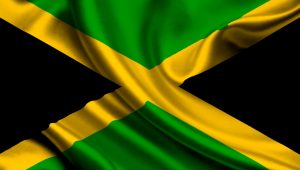 The Flag came into use on August 6, 1962, Jamaica’s Independence Day.
The Flag came into use on August 6, 1962, Jamaica’s Independence Day.
The Flag has a diagonal cross or saltire with four triangles in juxtaposition. The diagonal cross is GOLD and one-sixth of the length of the fly of the flag; the top and bottom triangles are in GREEN; and the hoist and fly triangles are in BLACK. The exact shade of green used in the flag is Emerald T8 17, British Admiralty Bunting Pattern.
The Flag follows the “Admiralty Pattern” and the proportion is 2 x 1.
“The sun shineth, the land is green and the people are strong and creative” is the symbolism of the colours of the flag. Black depicts the strength and creativity of the people; Gold, the natural wealth and beauty of sunlight; and green, hope and agricultural resources.
- The Flag must be regarded as a sacred emblem of the Nation to be paid due reverence and devotion by all its citizens.
- The Flag should never be allowed to touch the ground or floor.
- It should never be flown or used for purely decorative purposes on anything that is for temporary use and likely to be discarded, except on state occasions.
- When the Flag becomes worn and must be replaced it should be burnt and not used for any other purpose than what it was designed for.
- Except at Foreign Embassies, Consulates and Missions no foreign flag may be flown publicly, unless the Flag of Jamaica is also flown.
- The Jamaican Flag should never be smaller than any other flag flown at the same time.
- No other flag should be placed above or to the right of the Jamaican Flag. (Note: International usage forbids the display of the Flag of one nation above that of another nation in time of peace.)
- The Flag when carried in procession with another flag or flags should be on the marching right or if there is a line of flags, in front of the centre of that line.
- The Flag should not be draped over vehicles of any sort except on Military, Police and State occasions.
- The Flag should be flown in or near every Polling Station on election day.
The Flag should be flown at half-mast as a sign of official mourning when so declared by the Prime Minister’s office for a period determined by this office. - The Flag, when flown at half-mast, should be first hoisted to the peak for an instant and then lowered slowly to the half-mast position. It should be again raised to the peak before it is lowered.
- During the Ceremony of hoisting or lowering the Flag or when the Flag is passing in a parade or in a review, all persons present should face the Flag and stand at attention. Persons in uniform should salute. Men should remove their hats.
The Flag should be flown on all Government and Municipal buildings and offices, on or near the main administrative building, but it is recommended that if possible each day it should be lowered at sundown and raised at 8:00 a.m.
Schools
- The Flag should be flown on all Government-aided Schools when the school is in session.
- At the beginning and end of each term there should be a special Flag Raising and Lowering Ceremony so organised that performance in the Ceremony should be regarded as a special privilege.
- The National Pledge for schools should be recited on such occasions.
- It would be appropriate for any school to have a special Flag Raising Ceremony on the Anniversary of Independence.
- All Youth Camps, Clubs and Institutions for young people should fit similar ceremonies into their schedules.
Private Use
- The Flag may be flown on private buildings on all national and state occasions and should always be flown on any private building on the occasion of official visits by the Governor-General, and the Prime Minister.
- The Flag should be flown at the official residence of the Governor-General, his private Flag being also displayed when he is in residence.
- The Flag should be flown at the official residence of the Prime Minister when he is in residence.
- The Flag should be flown on the Governor-General’s and Prime Ministers cars.
Government Property
- All Government-owned ships, defense craft and light houses should fly the flag.
- All Government-owned air-craft, rail and motor vehicles should bear a representation of the Flag.
- All merchant ships of Jamaica registry should fly the Flag.
National Anthem
- All persons should stand at attention at the playing of the National Anthem and men should remove their hats. Persons in uniform should salute.
- The first verse of the National Anthem should be sung and/or played on the arrival and departure of the Governor-General and of the Prime Minister.
- The National Anthem may be sung and/or played on occasions of public gatherings.
- Singing of the National Anthem should form part of the ceremony of raising and lowering of the Flag at the beginning and end of term in schools and at Independence Celebrations.
Eternal Father bless our land
Guard us with Thy mighty Hand
Keep us free from evil powers,
Be our light through countless hours.
To our Leaders Great Defender,
Grant true wisdom from above.
Justice, Truth be ours forever,
Jamaica, Land we love
Jamaica, Jamaica, Jamaica land we love.
Teach us true respect for all,
Stir response to duty’s call,
Strengthen us the weak to cherish,
Give us vision lest we perish.
Knowledge send us Heavenly Father,
Grant true wisdom from above.
Justice, Truth be ours forever,
Jamaica, Land we love.
Jamaica, Jamaica, Jamaica land we love.
The Jamaican Arms
The original Arms were designed by William Sancroft, who later became Archbishop of Canterbury, and the use of the Royal Helmet and Mantlings together is a unique distinction accorded Jamaica. The original grant of arms was made in February 1661. However, there is a  contention that the date should be referred to as 1662 owing to the change in 1752 from the old style of dating to the new. Prior to 1752 the New Year began on March 25. Historians in referencing dates would use the new style of dating so that what was then 1661 would be 1662 to us.
contention that the date should be referred to as 1662 owing to the change in 1752 from the old style of dating to the new. Prior to 1752 the New Year began on March 25. Historians in referencing dates would use the new style of dating so that what was then 1661 would be 1662 to us.
The original Latin motto, “Indus Uterque Serviet Uni” has been changed to one in English: “Out of Many, One People”. The arms show a male and female Taino (Arawak) standing on either side of the shield which bears a red cross with five golden pineapples superimposed on it. The Crest is a Jamaican crocodile surmounting the Royal Helmet and Mantlings.
This is the official description of the Jamaican Coat of Arms as taken from the records of the College of Arms, London:
“For Arms, Argent on a Cross Gules five pine-apples slipped OR: and upon a representation of Our Royal Helmet mantled OR doubled Ermine, for the Crest, On a Wreath Argent and Gules, Upon a Log fesse wise a Crocodile Proper: And for the Supporters, On the dexter side a West Indian Native Woman holding in the exterior hand a Basket of Fruits and on the sinister side a West Indian Native Man supporting by the exterior hand a Bow all proper.”
Changes in the Coat of Arms: The Jamaica coat of Arms has seen quite a number of changes, but only three are officially recorded. These changes occurred in 1692, 1957 and 1962 respectively.
The use of the Coat of Arms should not be permitted without official sanction being first obtained from the Prime Minister’s Office.
Although the colours of the Supporters are described as all proper, that is, in natural colours, it should be noted that in the approved colour sketch the feathered headdress and feathered skirts are red and white.
The single feather in the female figure’s headdress is red, and the headband ermine is winter white. The three tall feathers on the male figure are red, the headband and the shorter feathers alternately red and white, commencing with the red (on the left as seen by the observer) and the ending with a white feather on the right. The waistbands on the feathered skirts of both supporters are red.
The strips of feathers making up the skirts are alternately red and white commencing with the red (on the left as seen by the observer) and ending with outer white feathers on the right.
National Flower, Tree, Fruit and Bird
With the approval of the Cabinet a select committee, known as the National Flower Committee, was appointed initially to make recommendations for the choice of a National Flower. They were later asked to extend their activities to include the choice of a National Tree, a National Fruit and a National Bird.
The Jamaica Horticultural Society had been giving consideration to the choice of a National Flower from 1959. A short list of 14 flowers had previously been prepared and given wide publicity in order to determine public opinion. On the basis of the response, the Jamaica Horticultural Society recommended to the National Flower Committee that the flower of the Lignum Vitae be chosen as the National Flower of Jamaica. This suggestion was approved.
The Flower Committee also recommended that the National Tree should be the Blue Mahoe; the National Fruit, the Ackee; the National Bird, the Doctor Bird or Swallow-Tail Humming Bird.
Widespread use of the national symbols – the Flower, Tree, Fruit and Bird – should be encouraged for souvenirs, decoration, planting and design.
Lignum Vitae (Guiacum officinale)
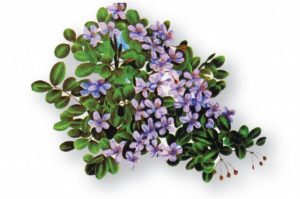 LIGNUM VITAE (Guiacum officinale) is indigenous to Jamaica and was found here by Christopher Columbus. It is thought that the name “Wood of Life” was then adopted because of its medicinal qualities. The tree grows best in the dry woodlands along both the North and South coasts of the island. In addition to shedding an attractive blue flower, the plant itself is extremely ornamental. The wood is used for
LIGNUM VITAE (Guiacum officinale) is indigenous to Jamaica and was found here by Christopher Columbus. It is thought that the name “Wood of Life” was then adopted because of its medicinal qualities. The tree grows best in the dry woodlands along both the North and South coasts of the island. In addition to shedding an attractive blue flower, the plant itself is extremely ornamental. The wood is used for
propeller shaft bearings in nearly all the ships sailing the Seven Seas, and because of these, in shipyears, etc., the Lignum Vitae and Jamaica are closely associated. The wood is also used in the manufacturing of curios, sought after by visitors and nationals alike. There is also a thriving export trade.
Blue Mahoe (Hibiscus elatus)
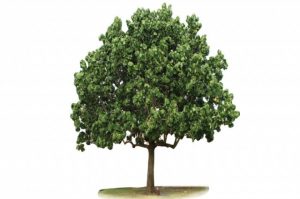 This has been regarded as one of our primary economic timbers. It is currently much used for reafforestation and is a valuable source of cabinet timber. Of an attractive blue-green colour with variegated yellow instrusions, it is capable of taking a high polish showing to advantage the variety of grain and colour tones. The trade, local and foreign, consumes annually many thousands of feet of this beautiful timber.
This has been regarded as one of our primary economic timbers. It is currently much used for reafforestation and is a valuable source of cabinet timber. Of an attractive blue-green colour with variegated yellow instrusions, it is capable of taking a high polish showing to advantage the variety of grain and colour tones. The trade, local and foreign, consumes annually many thousands of feet of this beautiful timber.
ACKEE (Blighia sapida)
Ackee was originally imported from West Africa in 1778 and was probThe Jamaica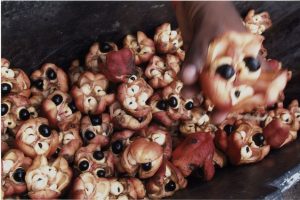 n National Fruitably brought here in a slave ship. It now grows luxuriously, producing each year large quantities of edible fruit.
n National Fruitably brought here in a slave ship. It now grows luxuriously, producing each year large quantities of edible fruit.
The tree was unknown to science until plants were taken from Jamaica to England in 1793 by Capt. William Bligh of “Mutiny on the Bounty” fame, hence the botanical name “Blighia sapida” in honour of the notorious Sea-Captain. One of the earliest local propagators of the tree was Dr. Thomas Clarke who introduced it to the Eastern parishes in 1778.
Jamaica is the only place where the fruit is generally recognised as an edible crop, although the plant has been introduced into most of the other Caribbean islands (Trinidad, Grenada, Antigua, Barbados), Central America and even Florida where it is known by different names and does not thrive in economic quantities.
Ackee is derived from the original name “Ankye” which comes from the TWI language of Ghana.
DOCTOR BIRD (Trochilus polytmus)
 The “Doctor Bird” or Swallowtail Humming Bird lives only in Jamaica and is one of the most outstanding of the 320 species of Humming Birds. It is well to note that the beautiful feathers of these birds have no counterpart in the entire bird population and produce iridescent colours, characteristics only of that family. The Doctor Bird has been immortalised for many decades in Jamaican folklore and songs.
The “Doctor Bird” or Swallowtail Humming Bird lives only in Jamaica and is one of the most outstanding of the 320 species of Humming Birds. It is well to note that the beautiful feathers of these birds have no counterpart in the entire bird population and produce iridescent colours, characteristics only of that family. The Doctor Bird has been immortalised for many decades in Jamaican folklore and songs.
PRAYER, PLEDGE AND SONG
While preparations for choosing the National Symbols progressed, the Minister of Education appointed a committee to see to the preparation of a National Pledge, a National Prayer and a National Song for use in all schools and similar institutions.
The following were finally chosen.
Let us Pray:
Let us give thanks for all God’s goodness and the wonderful heritage into which we have entered: For Jamaica, our Island home, the land of our birth –
Response: We give Thee thanks, O God.
For majesty of our hills, the beauty of our valleys, and the flaming loveliness of our gardens –
Response: We give Thee thanks, O God.
For the warmth and brightness of our days and the calm and peace of our countryside –
Response: We give Thee thanks, O God.
For the rich heritage of our people coming from many races, and yet one in purpose, in achievement, and in destiny, and for the dignity of labour and the service given by every citizen of our land –
Response: We give Thee thanks, O God.
For freedom, just laws and our democratic way of life –
Response: We give Thee thanks, O God.
For high privilege and responsibility of Independence and for bringing us to nationhood –
Response: We give Thee thanks, O God.
For our parents, teachers, religious and other leaders and all those who in every walk of life are helping to prepare us for responsible, citizenship, and for all those who are giving voluntary service in the public interest –
Response: We give Thee thanks, O God.
For the poets, artists and thinkers and all who create in us the vision of a new better society –
Response: We give Thee thanks, O God.
For godly heritage, the example of Jesus Christ and the sacrifices of our fathers in the faith –
Response: We give Thee thanks, O God.
The Response is: “Hear us we beseech Thee, O God.”
Bless, we pray Thee, our Queen, our Governor-General, our Prime Minister and other Ministers of State, our Parliament, and all who are sent in authority over us and grant that under them we may be peacefully and justly governed.
Response: Hear us we beseech Thee, O God.
Grant us love and compassion for all those in need and distress and help us to remove poverty and ignorance from our land, and grant us prosperity and true wisdom, we pray –
Response: Here us we beseech Thee, O God.
Forgive us all that is unworthy and evil in our national life, establish us in righteousness and inspire us to work for universal brotherhood, we pray –
Response: Hear us we beseech Thee, O God.
Guide and bless our nation, we pray, and make us loyal and dutiful citizens through Almighty God, the Father of us all.
Amen.
National Pledge
For use at the Beginning and End of Term, and on Other Special Occasions.
Before God and all mankind, I pledge the love and loyalty of my heart, the wisdom and courage of my mind, the strength and vigor of my body in the service of my fellow citizens, I promise to stand up for Justice, Brotherhood and Peace, to work diligently and creatively, to think generously and honestly, so that Jamaica may, under God, increase in beauty, fellowship and prosperity, and play her part in advancing the welfare of the whole human race.
Shorter Pledge for Schools
Before God and all Mankind I pledge my love, my loyalty and my skills in the service of Jamaica and my fellow citizens. I promise to work diligently and to help build a prosperous and peaceful nation.
National Song
The National Song for Schools is set to tune of “I Vow to Thee My Country”. It was written by Victor Stafford Reid.
I Pledge My Heart
| 1. I pledge my heart forever To serve with humble pride This shining homeland, ever So long as earth abide. |
2. I pledge my heart, this island As God and faith shall live My work, my strength, my love and My loyalty to give. |
3. O green isle of the Indies, Jamaica, strong and free, Our vows and loyal promises, O heartland, ’tis to thee. |
—Source: Facts on Jamaica: Code for National Symbols. – Kingston:
Jamaica Information Service, October 12, 1966
and National Library of Jamaica H/N National Symbols.
